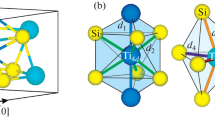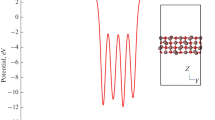Abstract
The atomic and electronic structure of the Al2O3/Ti5Si3 interface has been calculated for the first time by the method of projected augmented waves within the electron density functional theory. The values of the adhesion energy are determined depending on the cleavage plane. It is shown that the work of separation obtained for the plane passing through the interplanar distance closest to the interface in titanium silicide is significantly less than that at the interface.



Similar content being viewed by others
REFERENCES
W. E. Dowling, W. T. Donlon, and J. E. Allison, High-Temperature Ordered Intermetallic Alloys VI (MRS, Pittsburgh, 1995).
Z. Li and W. Gao, “High Temperature Corrosion of Intermetallics,” in Intermetallics Research Progress (Nova Science Publishers, New York, 2008).
J. Dai, J. Zhu, C. Chen, and F. Weng, “High temperature oxidation behavior and research status of modifications on improving high temperature oxidation resistance of titanium alloys and titanium aluminides: a review,” J. Alloys Compd. 685, 784 (2016). www.sciencedirect.com/science/article/pii/S0925838816319351.
X. Y. Li, S. Taniguchi, Y. Matsunaga, K. Nakagawa, K. Fujita, “Influence of siliconizing on the oxidation behavior of a γ-TiAl based alloy,” Intermetallics 11, 143 (2003). www.sciencedirect.com/science/article/pii/ S0966979502001930.
X. Weihao, Z. Liang, and J. Huiren, “Effects of Si on high temperature oxidation resistance of TiAl alloy,” J. Beijing Univ. Aeronaut. Astronaut. 32, 365 (2006).
H. R. Jiang, Z. L. Wang, W. S. Ma, X. R. Feng, Z. Q. Dong, L. Zhang, and Y. Liu, “Effects of Nb and Si on high temperature oxidation of TiAl,” Trans. Nonferrous Met. Soc. China 18, 512 (2008). www.sciencedirect.com/science/article/pii/S1003632608600904.
R. Swadzba, L. Swadzba, B. Mendala, B. Witala, J. Tracz, and K. Marugi, “Characterization of Si–Aluminide Coating and Oxide Scale Microstructure Formed on γ-TiAl alloy during long-term oxidation at 950 °C,” Intermetallics 87, 81 (2017). www.sciencedirect.com/science/article/pii/S0966979516307725.
J. Huang, F. Zhao, X. Cui, J. Wang, and T. Xiong, “Long-term oxidation behavior of silicon-aluminizing coating with an in-situ formed Ti5Si3 diffusion barrier on γ-TiAl alloy,” Appl. Surf. Sci. 582, 152444 (2022). www.sciencedirect.com/science/article/pii/S016943322 2000277.
A. V. Bakulin, S. S. Kul’kov, and S.E. Kul’kova, “Adhesive properties of the TiAl/Al2O3 interface,” Izv. Vyssh. Uchebn. Zaved. Fiz. 63, 3 (2020). www.elibrary.ru/item.asp?id=42952362.
A. V. Bakulin, S. S. Kul’kov, and S.E. Kul’kova, “Effect of metal and oxide intermediate layers on the adhesive properties of the Ti3Al/Al2O3 interface,” Izv. Vyssh. Uchebn. Zaved. Fiz. 64, 24 (2021). www.elibrary.ru/ item.asp?id=45698002.
P. E. Blöchl, “Projector augmented-wave method,” Phys. Rev. B 50, 17953 (1994). https://journals. aps.org/prb/abstract/10.1103/PhysRevB.50.17953.
G. Kresse and D. Joubert, “From ultrasoft pseudopotentials to the projector augmented-wave method,” Phys. Rev. B 59, 1758 (1999). https://journals. aps.org/prb/abstract/10.1103/PhysRevB.59.1758.
S. Hocker, A. Bakulin, H. Lipp, S. Schmauder, and S. Kulkova, “Atomistic Simulations of Metal–Al2O3 Interfaces,” in Handbook of Mechanics of Materials (Springer, Singapore, 2019). https://link.springer.com/ referenceworkentry/10.1007/978-981-10-6884-3_9.
L. S. Chumakova, A. V. Bakulin, and S.E. Kul’kova, “Electronic structure and mechanical properties of Ti5Si3” JETP 134, 73–753 (2022).
ACKNOWLEDGMENTS
Numerical calculations were carried out on the SKIF Cyberia supercomputer at Tomsk State University.
Funding
This work was supported by the Russian Science Foundation (project no. 22-23-00078).
Author information
Authors and Affiliations
Corresponding author
Ethics declarations
The authors declare that they have no conflicts of interest.
Rights and permissions
About this article
Cite this article
Chumakova, L.S., Bakulin, A.V. & Kulkova, S.E. Atomic and Electronic Structure of the Al2O3/Ti5Si3 Interface. Phys. Part. Nuclei Lett. 20, 1135–1137 (2023). https://doi.org/10.1134/S1547477123050217
Received:
Revised:
Accepted:
Published:
Issue Date:
DOI: https://doi.org/10.1134/S1547477123050217




